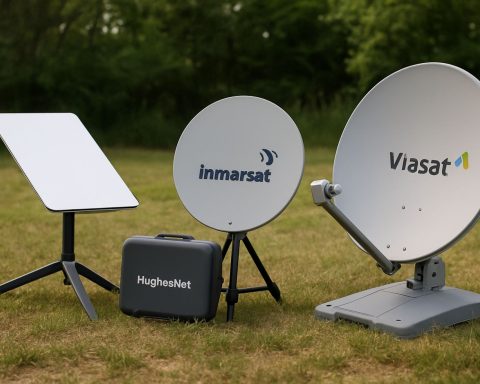- Nvidia is strategically investing in AI technologies, shaping the future of innovation and technology.
- The company takes a significant stake in Arm Holdings, influencing the future of semiconductor architecture powering smartphones.
- Nvidia is enhancing AI data center capabilities through investments in Applied Digital, aiming for significant capacity growth by 2027.
- Through Recursion Pharmaceuticals, Nvidia targets biotechnology transformation, leveraging AI for drug discovery and healthcare advancements.
- The investment in Nebius Group underscores Nvidia’s commitment to expanding the AI cloud market to support diverse industries.
- Nvidia invests in WeRide, accelerating development in autonomous vehicles across multiple cities, signaling a push toward autonomous mobility.
- These strategic moves position Nvidia as a leader not just in technology trends, but in fundamentally reshaping global technology infrastructure.
Beneath the hum of the Wall Street frenzy, Nvidia quietly orchestrates an investment symphony, channeling the AI zeitgeist into a future that pulses with innovation and untapped potential. While the company’s AI prowess is no secret—propelling it into the pantheon of tech titans—its stealthy investment maneuvers reveal an audacious vision that seeks to sculpt the coming era of technology.
At the forefront of this secretive power play is Arm Holdings, a storied name in the sprawling domain of semiconductors. Nvidia’s stake in Arm resonates with audacious foresight, investing heavily in their energy-efficient architecture that powers 99% of the world’s smartphones. As society sprints toward a trillion-dollar AI demand by 2030, Arm’s designs are poised to infiltrate the heart of mobile AI and beyond, igniting a revolution from the palm of our hands to the vast expanses of data centers.
Venturing into the digital deluge, Nvidia backs Applied Digital, a company fueling the appetite for AI-powered data centers. Their symbiotic relationship, welded by Nvidia’s cutting-edge GPUs, taps into the swelling hyperscaler demand. With ambitious plans to supercharge its capacity to 2 gigawatts by 2027, Applied Digital stands as a testament to tech’s unquenchable thirst for power and speed—a race Nvidia fuels with quiet determination.
In a surprising turn, the realm of pharmaceuticals finds itself in Nvidia’s orbit with the investment in Recursion Pharmaceuticals. Leveraging AI for a radical overhaul of drug discovery processes, this biotech company’s quest underscores a transformative era where algorithms could potentially decipher the mysteries of medicine faster than ever before—paving the way for quicker, more cost-effective cures.
Amid the data-driven cosmos, Nebius Group emerges, seeking to seize the burgeoning AI cloud market. Nvidia’s strategic participation in Nebius, along with notable investors like Accel, articulates a vision of a future where AI development accelerates at an unprecedented pace, harnessing the capabilities of cutting-edge cloud technology to feed industries as varied as healthcare and automotive.
Lastly, Nvidia’s gaze turns to the roads of tomorrow, investing in WeRide, a pioneer in the autonomous vehicle sector. With technological roots already entwined in Nvidia’s advanced AI computer systems, WeRide’s expansion across 30 cities is but a prelude to an AV revolution, navigating not only vehicles but Nvidia’s aspirations on a global trajectory.
Through its strategic investments, Nvidia’s portfolio reflects a deeper narrative—a resolute belief in AI not just as a technological trend, but as a fundamental shift in how the world operates. In these bold pursuits, Nvidia does not merely follow the present; it carves the path ahead, inviting those with vision to journey alongside it. As investors scan the horizon for the ‘next Nvidia,’ these covert investments could be glimpses of the future unfolding, ripe with opportunities to redefine what technology means in our rapidly evolving world.
Unlocking the Secrets of Nvidia’s Strategic Investments: The AI Revolution is Here
Nvidia’s Strategic Moves: An In-Depth Analysis
Nvidia, a leader in AI technologies, is quietly but assertively securing its future through strategic investments across various sectors. Here’s a closer look at the lesser-known aspects of these investments, and what they could mean for the future of technology.
Arm Holdings: The Semiconductor Giant
Fact: Arm Holdings designs over 99% of the world’s smartphone chips, and its energy-efficient architecture is set to revolutionize AI integration into mobile technologies, facilitating the trillion-dollar AI demand forecasted by 2030.
How It Impacts You: With AI becoming more ubiquitous in mobile devices, users can expect enhanced functionalities like advanced voice recognition, superior image processing, and improved battery life thanks to Arm’s efficient designs.
Applied Digital: Powering the Future of Data Centers
Details: Nvidia leverages its cutting-edge GPUs to support Applied Digital’s expansion plans. This partnership aims to increase Applied Digital’s data processing capacity to 2 gigawatts by 2027.
Real-World Use Case: As data demands grow, businesses—from startups to large enterprises—rely on AI-powered data centers for everything from real-time analytics to enhanced cloud computing, making this investment critical for the digital economy.
Recursion Pharmaceuticals: AI Meets Biotech
Overview: Recursion Pharmaceuticals uses AI to transform drug discovery, aiming for faster and more affordable healthcare solutions.
Industry Trends: The application of AI in biotech is set to streamline R&D, reduce the time required to bring drugs to market, and potentially lower healthcare costs significantly.
Pros & Cons: While AI can accelerate drug discovery, ethical concerns and regulatory challenges remain potential hurdles.
Nebius Group: Dominating the AI Cloud Market
Insight: With Nvidia’s involvement, Nebius Group seeks to accelerate AI development across industries such as healthcare and automotive, utilizing next-gen cloud technologies.
Security & Sustainability: Emphasizing sustainable practices, the AI cloud industry is innovating to reduce carbon footprints while enhancing security protocols to protect sensitive data.
WeRide: Pioneering Autonomous Vehicles
Facts: WeRide is at the forefront of self-driving technology, with operations across 30 cities.
Future Prediction: The autonomous vehicle market is expected to burgeon as regulatory approval grows and technology becomes more advanced, paving the way for smarter, more connected urban environments.
Market Forecast: Research indicates the global autonomous vehicle market may grow from $54.23 billion in 2019 to approximately $556.67 billion by 2026, highlighting the substantial opportunities in this domain.
Additional Insights and Recommendations
FAQs:
– Why is Nvidia investing in such diverse sectors?
Nvidia is diversifying its portfolio to mitigate risks and capitalize on emerging AI trends across multiple industries.
– What does this mean for investors?
Nvidia’s strategic foresight offers investors opportunities in sectors poised for explosive growth, led by AI innovation.
Actionable Recommendations:
1. Invest in AI and Semiconductor Stocks: Keep an eye on companies like Arm and Nvidia to capitalize on the AI momentum.
2. Explore AI in Healthcare: As the sector is due for transformative growth, both investment and career opportunities in AI-driven biotech firms are expanding.
3. Stay Informed on AV Developments: Monitor autonomous vehicle advancements to leverage market opportunities as they arise.
For more technology insights and market trends, visit Nvidia’s official website.
Conclusion
Nvidia’s strategic investments are setting the stage for significant advancements across multiple sectors, driven by AI innovation. Whether through more integrated mobile technology, accelerated drug discovery, expanded data capabilities, robust AI cloud infrastructure, or advancements in autonomous vehicles, Nvidia is carving a path toward a technologically enhanced future. By understanding and capitalizing on these trends, investors and industry professionals can be well-positioned to benefit from the next wave of technological progress.










